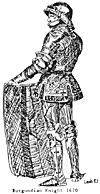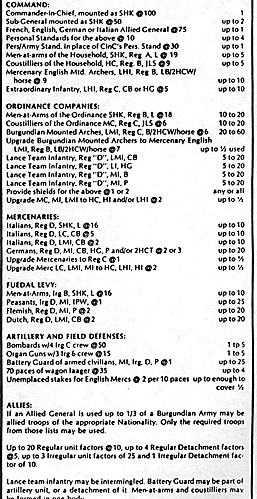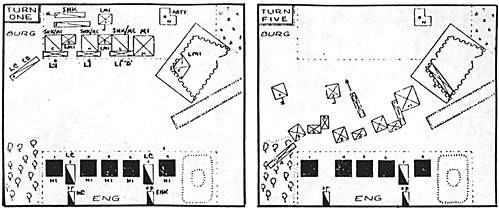 The four Valois Dukes of Burgundy were able men. After a century of patient labor the Dukes had created a major European power which reached from the Alps to the North Sea. The French Kings and the German Emperors strove in vain to halt the growth of that power. In its prime Burgundy was one of the richest, most cultured and most powerful states of Europe.
The four Valois Dukes of Burgundy were able men. After a century of patient labor the Dukes had created a major European power which reached from the Alps to the North Sea. The French Kings and the German Emperors strove in vain to halt the growth of that power. In its prime Burgundy was one of the richest, most cultured and most powerful states of Europe.
Burgundian Knight 1470
Charles the Bold, last Valois Duke of Burgundy, was the only ruler of his day to dimly see the revolution in warfare caused by gunpowder. Through a process of trial and error, combined with careful analytical meditation, Charles created an army that bridged the Medieval and Renaissance (,eriods. His military establishment has been called the "first modern army", and it generally influenced European military development.
 ARMY AND UNIT ORGANIZATION
ARMY AND UNIT ORGANIZATION
Before Charles the Burgundian army resembled those of other European states. Orders of battle surviving from the reign of Duke John the Fearless reveal that Burgundian forces were composed of Feudal levies, mercenaries and allies in about equal proportions. In 1468 AD Charles started the creation of a standing army composed of volunteers and mercenaries.
The main building block of this new organization was the "lance team". A lance team was usually composed of eight or nine men. The composition varied somewhat over the years but most frequently consisted of a knight, page, coustilier, two or three mounted infantry archers, and three or four infantry. One hundred lance teams would combine to form an "Ordnance Company"-so called because they were governed by Ducal ordinances, or regulations. The Burgundian order of battle in 1472 may be considered typical.
There were twelve Ordinance Companies with the following strength: Knights: 1200; Coustiliers: 1200; Mounted Archers: 3000; Foot Crossbows: 600; Foot Archers: 1000; Pikemen: 2000; Handgunners: 600; Total: 9,600 combatants. This total excludes artillery, mercenaries not absorbed into the Ordinance and the local/short term feudal levies which were still used. The troops were usually organized into units of about 100 men, although understrength or overstrength situations are known. Knights and Coustiliers were brigaded together.
The Ordinance Companies were very flexible combined-arms organizations. Numerous combinations were possible and tried Sometimes the Knights would dismount and intermingle with the foot archers, the pikes would intermingle with the archers, etc.
Charles' military ordinances painstakingly spelled out the when and how of training, the chain of command and duties of the officers, troop conduct and unit coordination. The full time paid status of the troops, their officering, and the compulsory drill and maneuvers qualify them as "regulars."
The pressure of the Swiss war caused Charles to re-organize the Ordinance Companies into eight divisions. Six of these divisions had 500 pikemen, 600 foot archers, 400 knights, 400 coustiliers and 800 mounted officers. One division had double the above number of infantry of various types and the last division was composed of Household troops.
TROOP EQUIPMENT AND UNIFORMS
Soldiers were expected to provide their own arms while the uniforms were provided by the State. Ordinances spelled out the minimum equipment required. Inspections were held frequently to ensure that the troops were properly equipped. It was not unusual for the soldiers to provide more arms and armor than the Ordinances required.
Knights supplied a complete suit of plate armor, three good horses, a combat saddle and chamfrain, lance and sword. Coustiliers brought a good javelin, a medium length single-handed sword, a foot long double edge dagger and horse. The mounted infantry archers were required to have a bow, thirty good arrows, long two handed sword and dagger.
The Ducal colors were blue and white. The knights were issued blue and white plumes for their heads and the heads of their horses. The knights were also given red velvet St. Andrew's crosses to place on their breastplates. Coustiliers and mounted archers received a coat half blue and half white, although quartered blue and white was not unknown.
Infantry of the Ordinance used one handed swords and either a bow, crossbow, handgun or pike. Other infantry would be armed as the ordinance, although German mercenaries sometimes used polearms. Flemish infantry used pikes and word red caps. Dutch infantry used crossbows with the Dordrecht Levy wearing red and white hoods, while men from the Hague wore black hoods and Delft men wore white hoods. Most Italian infantry used crossbows. Brabant provided foot archers.
Mounted crossbows were supplied by the provence of Burgundy and Italians. English longbowmen were a popular and sought after mercenary, being armed and equipped as Ordinance mounted archers.
A large quantity of artillery characterized Burgundian armies. This reflected both Burgundian wealth and Charles' desire to have the best equipment possible. Tube to men ratios ran from 1:120 to 1:200, which is a very high percentage of artillery for any period. It was proposed that camp followers and sappers be issued pikes and serve as battery guards, but I am unsure if this became a concrete practice.
The Ducal Army Standard was made of white taffeta with a picture of St. George, mounted on a horse, fighting the dragon which was breathing fire in all directions. The Standard bore the Duke's motto "Je I'ay emprins" (I have undertaken it), along with a St. Andrew's cross and other Burgundian emblems. The Household troops had similar standards, with St. George depicted as fighting on foot.
TACTICAL USE ON THE WARGAMES TABLE
Because the knights are expensive, a Burgundian army is usually outscouted and outnumbered. The Burgundian flanks should be secured with gullies, marches and villages.
Some armies, like Vikings, have a high proportion of general purpose troops. The Burgundians, however, are an army of specialists. Victory is obtained by interweaving the specialists in a compatable manner. Defeat results from using a troop type in ways not suited for its weapons, formation and morale. Command control is the key. Fortunately the W.R.G. 6th edition is generous in this regard and with a little forethought your units can advance, retire, shuffle about, dismount and remount just about as you desire. Since control is important avoid going impetuous as this will wreck unit coordination.
The army has a thin cutting edge of knights. The knights are the tip of the spear and they close with and pin the enemy in melee. They are so few and so expensive that they should not be used in reserve, but must be out front. An attacker usually avoids strength and concentrates against weakness. Experience, however, has shown that the knights must be hurled against the strongest point in the enemy line. The enemy's shock units must be tied up and immobilized as soon as possible. The Burgundians have a great mounted infantry and dismounted cavalry capability. You can move rapidly to the point of decision and, if necessary, dismount to fight. If the knights are facing mounted enemy or LI they normally remain mounted. Otherwise, they dismount when in javelin range of the foe.
The coustiliers beef up the size of the Burgundian shock units by filling in behind the SHK. This makes it difficult for the enemy to obtain a C.P.F. In the dismounted mode their javelins assist in melee When facing crossbows or exotics like elephants and scythed chariots the coustiliers interpenetrate up to the front of the unit.
The mounted archers move in company with the knights and provide close-in missile support for them. If the enemy routs at the knights first shock, the archers remount and pursue while the knights refrain from pursuit. If the enemy is pinned by the knights the archers charge through the intervals and encourage the halted enemy to recoil. High quality English mounted archers make a useful reserve under the command of a sub-general.
The LI handgunners are a missile screen for the advancing knights, especially when faced with slings or longbows. These absorb long range missiles as long as their morale permits. When the lines close the LI is pulled out of the way, or is charged through, and support with fire through the intervals. Holding fire may prove useful and allow the Burgundians to disorder enemy animals
The foot crossbows are useful in defending ramparted villages and steep hills. The enemy will have difficulty in casually dislodging these troops from those positions and they can support the knights with long range overhead fire. An "X" target priority is useful since they are good against armored cavalry.
The lance team pikes and foot bows are combined. These support the shoulders of the knightly attack. This type of unit can respond to enemy missiles and fend off enemy mounted troops. They can not withstand a major enemy push and if one is coming their way you have made a miscalculation and must quickly adjust.
The LC crossbows help with the scouting and can screen a dangling flank. Their long range weaponry helps them to keep out of trouble. If you are faced with mass elephant units they operate best behind the main battle line shooting at the beasts.
Bombards are an expensive ornament. They can be used on an enemy reluctant to close and against enemy elephants.
An organ gun might prove effective in a palisaded village. If the enemy makes a serious attempt to storm it, the gates are opened and the gun shoots. The combination of missiles, artillery, surprise and unfriendly cover will halt all but elite troops.
AN EXAMPLE BATTLE
This miniature battle was between Burgundians and Medieval English. Figures used were 15mm while the rules were WRG's 6th Edition. Forces were 1250 points on a slightly cramped field of 700 paces by 500 paces. Army orders of battle were:
BURGUNDIANS
A. LC, Reg "D", crossbow, 9 figs
B, G & K. LI, Reg "D", handgun, S figs each
C, H & L. 5HK, Reg "B", lance, 5 figs & MC, Reg "C", Javelins,
5 figs each
D,I & E. LMI, Reg "C", bow/2 hnd swd/horse, 10 figs ea.
F. General, SHK, Reg "A", lance, 3 figs & HC, Reg "B", javs,
3 figs.
J. Sub-General, LMI, Reg "B", Ingbw/2 hnd swd/hrse 10figs.
M. MI, Reg "D", 16 figs w/bow & 16 figs w/pike.
N. Artillery, one bombard and one organgun, Irg "C".
O. LMI, Reg "D", crossbow, 11 figs.
Noteworthy is that almost 50% of the Burgundian army is "D" Class.
English
1, 4,5 & 6. HI, Reg "B", 8 figs w/bill and 16 figs w/longbow
9. HI. Reg "B", 7 figs w/bills and 12 figs w/longbows 2 & 7. LC, Irg "C'", lance/x-bow/shield, 6 figs ea
3. Sub-General & HC, Reg "C", lance/shield, 5 figs
6. General, EHK, Reg "B", lance/shield, 5 figs.
The Burgundians secured their left flank with a marsh, palisaded village and gully. The English secured both of their flanks with a wood and steep hill. Since both armies used large numbers of missile troops they were careful to keep clear fields of fire between each other. Initial deployment was as illustrated with neither army being out-scouted. The English took a defensive position trying to maximize their longbows. The Burgundians force marched the foot crossbows to the forward ramparts of the village, and force marched the mounted crossbows out on the right flank to screen a contemplated envelopment On the Burgundian left the mixed bow/pike unit placed the archers to the front with the pikes ready to interpenetrate forward if the enemy got close. The light infantry screened the knights, whilw the mounted archers were mostly dismounted to fire through the intervals and serve as a second assault wave
The Burgundians commenced a left wheel, pivoting on the village. The English sent forward a LC unit to slow down the Burgundian advance, but a brish missile volley caused that unit to retire shaken. English missiles fell mostly on expendable Burgundian "D" class infantry. As the lines closed one Burgundian LI unit was driven off with missiles and the other two were contracted out of the way, while the Knights dismounted. The Burgundian mounted crossbows reached the woodline, dismounted and started to flank the English position. The English interpenetrated the billmen forward.
The second map shows unit positions at the start of Turn #5. The right most English unit wheeled towards the Burgundians while the rest of the English infantry charged the enemy to their front. English #1 recoiled their LMI opponent, but recoiled itself from the dismounted Knight unit C. Unit #4 recoiled Unit D. Units #5 & 6 broke outright. On turn six Unit #9 was faced with heavy bow and crossbow casualties, artillery fire, unfriendly cover, routs, etc and stalled being picked to pieces subsequently by point blank bow fire. The victorious Knights were able to refrain from pursuing and they remounted. The Burgundian reserve unit moved up into a position to strike Unit #4, when it broke unit D. Assisted by close-in missile fire, Knights C broke Unit #1.
The start of turn #7 saw three English units in rout to one Burgundian unit. The English Commander conceded. Burgundian execution was sloppy in that the mounted archers were pushed to far forward and were caught by the English charge.

BIBLIOGRAPHY
Unlike most ancient armies there is a mass of information available on the late Burgundian army. A person who can read French can, for example, discover the names of the more than 200 bodyguards of Charles the Bold. The best accounts of Burgundy, in the English language, is the five volume series by Richard Vaughan These are:
Vaughan. These are: Phillip the Bold, Harvard, 1962, Phillip the Good, N.Y., 1970, Charles the Bold, N.Y , 1974; Valois Burgundy, Hampden, Conn., 1975; John the Fearless, London, 1979.
The above can be usefully supplemented by Commines, Phillipes de, Memoirs, Columbia, S C , 1969, and Kirk, John F., History of Charles the Bold, 3 vol Phila., 1864.
Back to Saga v5n4 Table of Contents
Back to Saga List of Issues
Back to MagWeb Master Magazine List
© Copyright 1991 by Terry Gore
This article appears in MagWeb (Magazine Web) on the Internet World Wide Web. Other articles from military history and related magazines are available at http://www.magweb.com